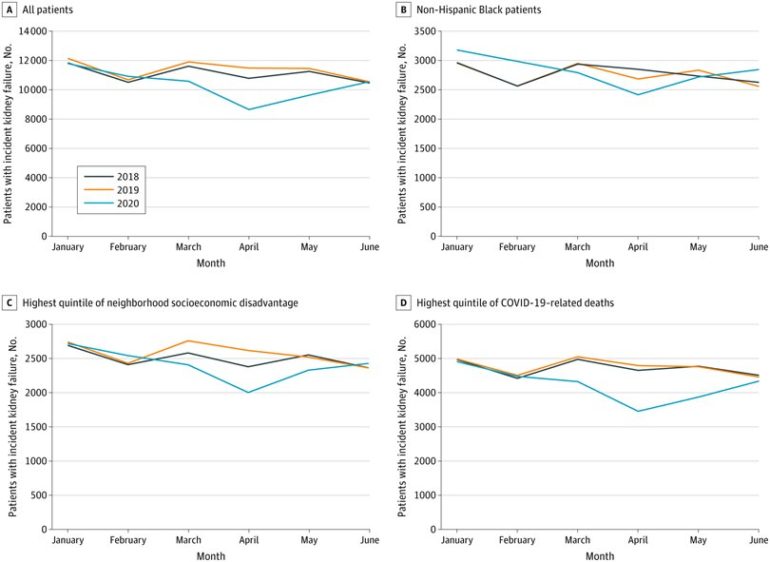In the four months following the COVID-19 pandemic’s arrival in the U.S., the number of patients initiating treatment for kidney failure declined by 30%, a new study in JAMA Network Open found. Notably, Black patients and patients living in counties with high numbers of COVID-19 deaths initiated treatment with significantly worse levels of kidney function when compared to prior years.
Lead author Kevin Nguyen, an investigator at Brown University’s School of Public Health, said that unfortunately, the results do not mean that patients with chronic kidney disease had fewer incidents of failure or had healthier kidneys. Rather, the decline in patients with kidney failure likely reflects decisions to delay treatment or changes in how health care was delivered early in the pandemic. Treatments often include regular dialysis or kidney transplants, two options disrupted after COVID-19’s arrival.
“Treatment in the form of dialysis or a transplant is essential for the survival of people with chronic kidney disease,” Nguyen said. “Missed routine care could be potentially catastrophic. So understanding whether and how these initiations of treatment changed with respect to the pandemic is really important.”
The goal of the study was to look at how the number and characteristics of patients initiating treatment for newly diagnosed kidney failure changed during the pandemic, Nguyen said. Because the burden of the pandemic has disproportionately impacted people of color and members of low-income families, the researchers also wanted to examine changes specifically within those groups.
They used data from the Renal Management Information System Medical Evidence Form, a national census of all patients with kidney failure who initiate long-term dialysis or receive a preemptive kidney transplant. They studied the changes in the number of patients with kidney failure initiating treatment as well as estimated glomerular filtration rate (eGFR), a key measure of kidney function, for the period of March 1 to June 30, 2020, and compared the numbers to the corresponding periods in 2018 and 2019. The researchers segmented their analysis by race/ethnicity, county-level COVID-19 mortality and neighborhood socioeconomic characteristics.
Compared to the pre-COVID-19 years, March through June 2020 saw significant decreases in the percentage of patients with kidney failure who received preemptive transplants (2.1% pre-COVID-19 vs. 1.4% during COVID-19) or initiated dialysis treatment (15.8% pre-COVID-19 vs. 13.4% during COVID-19). In April 2020, the number of patients initiating treatment for kidney failure was approximately 30% lower than trends in prior years.
Declines in the measurement of kidney function were observed exclusively among non-Hispanic Black patients (8.4 mL/min/1.73 m2 pre-COVID-19 to 8.1 during COVID-19). There were significant declines in eGFR for patients residing in counties with the highest number of deaths from COVID-19 (9.5 vs. 9.2 during the pandemic), but not for patients residing in other counties.
“In the early months of the pandemic, not only were there declines in the number of people initiating treatment for kidney failure, but for some groups, when they did initiate treatment, it was when they had lower kidney function,” Nguyen said.
The largest reduction in the number of patients seeking treatment compared to prior years was in April 2020. Nguyen said that while a gradual rebound in treatment initiation occurred in the later months, it still didn’t reach pre-pandemic levels.
The study findings underscore the importance of maintaining continuity of care and improving care for people with chronic kidney disease, Nguyen said, both throughout the pandemic and after it eventually subsides.
“Any disruption in care can have grave consequences for these patients,” he said.
The study wasn’t designed to examine the specific mechanisms driving these changes, but Nguyen said plausible explanations include patients delaying treatment for fear of getting sick, limited appointment availability, financial or logistical barriers to accessing care, as caused by the economic repercussions of the pandemic. He also noted that in some cases, the provider and patient together may have decided to postpone a transplant.
Study reveals high burden of COVD-related deaths among kidney transplant recipients and patients with kidney failure
More information:
Kevin H. Nguyen et al, Evaluation of Racial, Ethnic, and Socioeconomic Disparities in Initiation of Kidney Failure Treatment During the First 4 Months of the COVID-19 Pandemic, JAMA Network Open (2021). DOI: 10.1001/jamanetworkopen.2021.27369
Citation:
Fewer patients sought treatment for kidney failure in early months of COVID-19 pandemic (2021, October 14)
retrieved 14 October 2021
from https://medicalxpress.com/news/2021-10-patients-sought-treatment-kidney-failure.html
This document is subject to copyright. Apart from any fair dealing for the purpose of private study or research, no
part may be reproduced without the written permission. The content is provided for information purposes only.


